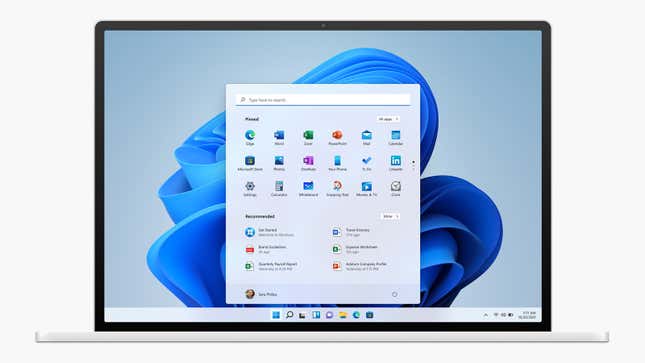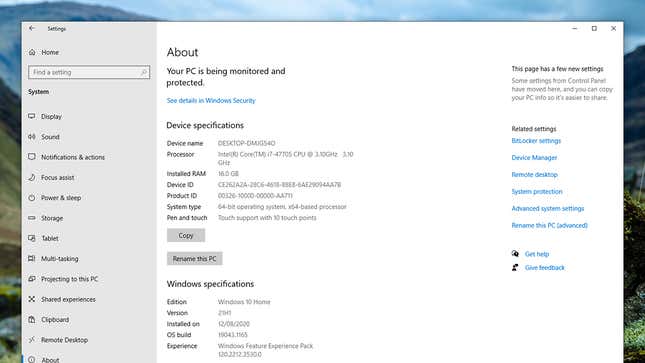
Windows 11 is on the way, and if you’re curious, you can actually try it out right now. If you’d rather wait for polished public version of Microsoft’s next operating system to be released, there are some things you need to check on your PC ahead of time to make sure there’s a smooth and stress-free transition.
Check the System Requirements
Checking the system requirements for Windows 11 is perhaps more difficult than it should be, because Microsoft published a minimum spec, then tweaked it, then waived certain parts of it for the testing period, leaving us all thoroughly confused about which computers would be able to run the new operating system and which wouldn’t.
Right now, the list of system requirements includes a 1GHz or faster CPU, 4GB of RAM, and 64GB of storage. You’re also going to need a version 2.0 Trusted Platform Module (TPM), which takes care of various security-related duties—TPMs are included on most modern motherboards, so you may already have one.

If your desktop or laptop doesn’t meet the base qualifications, then Microsoft says “you may not be able to install Windows 11"—although at the moment it’s not clear whether the company will let you try anyway. The specs list is actually relatively basic, and if your machine doesn’t meet the standards, then we might suggest upgrading your PC.
There are some additional feature-specific requirements beyond the basic specs, covering parts of the operating system like two-factor authentication (you’ll need a PIN, biometric entry method, or a smartphone for this). If you want to take advantage of the new DirectStorage system for games, you’ll need an NVMe SSD as one of your storage drives.
Check Your Files and Backups
When you go through the Windows 11 upgrade process, all of your applications, files, and folders should still be intact when you finish. That’s what should happen... and that’s what will happen, for the majority of users. But you should always have a backup of your most important files and folders somewhere, whether or not you’re upgrading to a new operating system.
If you’ve been doing your daily computing without the safety net of backups in place, now’s the time to change that. Use the File History tool that comes as part of Windows: From Settings go to Update & Security, then Backup, then click the Add a drive option to choose where you want to save copies of your files.

Many people now turn to cloud storage services to keep important files backed up on the web and synced to multiple devices at once. Google Drive, Dropbox, or OneDrive (the obvious choice for Windows, as it’s built right in) are all good options. You’ll need to pay a monthly subscription fee to store a serious number of files, but it’s usually good value. The Google Drive desktop software has just been updated to make it easier to use as a backup solution for Windows.
Even if all your key files are stored on the web, we’d recommend keeping a local copy on an external hard drive as well and updating it once a week or so. Not only does it give you another option if something disastrous should happen to your cloud locker (or your internet connection), it’s typically much quicker to restore files from a local drive than download terabytes of data over your broadband connection.
Check Your Installed Software
It’s worth noting that not all of the features and native tools of Windows 10 are going to make it to Windows 11—if there’s something in this list that you’ve come to love and rely on, then you might want to hold off on upgrading to the next operating system until you’ve found a suitable replacement or workaround.
When it comes to checking everything currently installed on your system, just click the Apps entry on the main Windows Settings pane to see a list. You can sort it based on file size and date of installation, so if there are any programs you’re not really using any more, you might want to get rid of them, especially if they’re taking up a lot of room—the more space you’ve got to install Windows 11, the better.

As with your files, installing Windows 11 shouldn’t interfere with your applications, but it’s best to prepare for the worst anyway. Make sure that you know how to re-download and reinstall all of your most important software packages (double-check on license codes, download locations, and so on), just in case you need to start again from scratch—and make sure all your projects, saved games, and the like are backed up somewhere.
We haven’t heard of any Windows 10 program that’s going to refuse to run on Windows 11, but there’s always a chance with particularly old software. If you regularly rely on a program that hasn’t been updated in a few years, you might want to contact the developer to make sure it’ll work with the new operating system—and perhaps hold off on installing Windows 11 until you’ve confirmed.